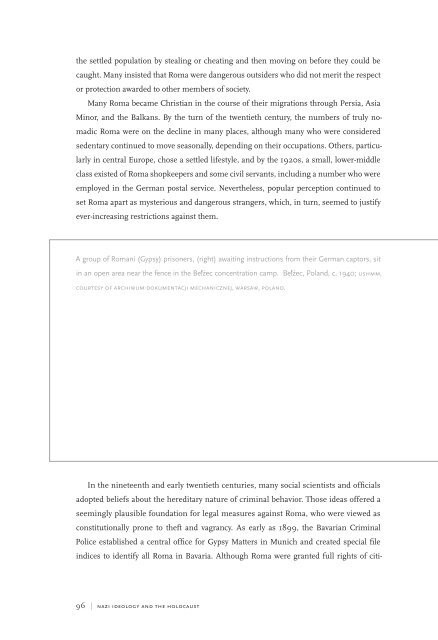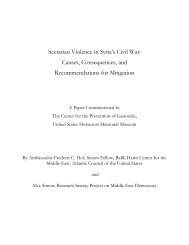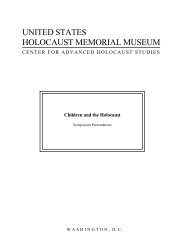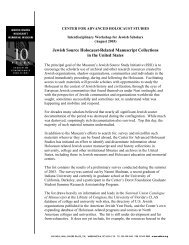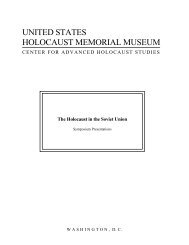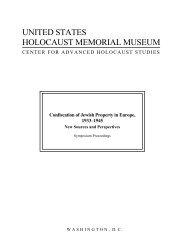the quest for racial purity - United States Holocaust Memorial Museum
the quest for racial purity - United States Holocaust Memorial Museum
the quest for racial purity - United States Holocaust Memorial Museum
Create successful ePaper yourself
Turn your PDF publications into a flip-book with our unique Google optimized e-Paper software.
<strong>the</strong> settled population by stealing or cheating and <strong>the</strong>n moving on be<strong>for</strong>e <strong>the</strong>y could be<br />
caught. Many insisted that Roma were dangerous outsiders who did not merit <strong>the</strong> respect<br />
or protection awarded to o<strong>the</strong>r members of society.<br />
Many Roma became Christian in <strong>the</strong> course of <strong>the</strong>ir migrations through Persia, Asia<br />
Minor, and <strong>the</strong> Balkans. By <strong>the</strong> turn of <strong>the</strong> twentieth century, <strong>the</strong> numbers of truly no-<br />
madic Roma were on <strong>the</strong> decline in many places, although many who were considered<br />
sedentary continued to move seasonally, depending on <strong>the</strong>ir occupations. O<strong>the</strong>rs, particu-<br />
larly in central Europe, chose a settled lifestyle, and by <strong>the</strong> 1920s, a small, lower-middle<br />
class existed of Roma shopkeepers and some civil servants, including a number who were<br />
employed in <strong>the</strong> German postal service. Never<strong>the</strong>less, popular perception continued to<br />
set Roma apart as mysterious and dangerous strangers, which, in turn, seemed to justify<br />
ever-increasing restrictions against <strong>the</strong>m.<br />
A group of Romani (Gypsy) prisoners, (right) awaiting instructions from <strong>the</strong>ir German captors, sit<br />
in an open area near <strong>the</strong> fence in <strong>the</strong> Belz . ec concentration camp. Belz . ec, Poland, c. 1940; ushmm,<br />
courtesy of archiwum dokumentacji mechanicznej, warsaw, poland.<br />
In <strong>the</strong> nineteenth and early twentieth centuries, many social scientists and officials<br />
adopted beliefs about <strong>the</strong> hereditary nature of criminal behavior. Those ideas offered a<br />
seemingly plausible foundation <strong>for</strong> legal measures against Roma, who were viewed as<br />
constitutionally prone to <strong>the</strong>ft and vagrancy. As early as 1899, <strong>the</strong> Bavarian Criminal<br />
Police established a central office <strong>for</strong> Gypsy Matters in Munich and created special file<br />
indices to identify all Roma in Bavaria. Although Roma were granted full rights of citi-<br />
96 | nazi ideology and <strong>the</strong> holocaust


